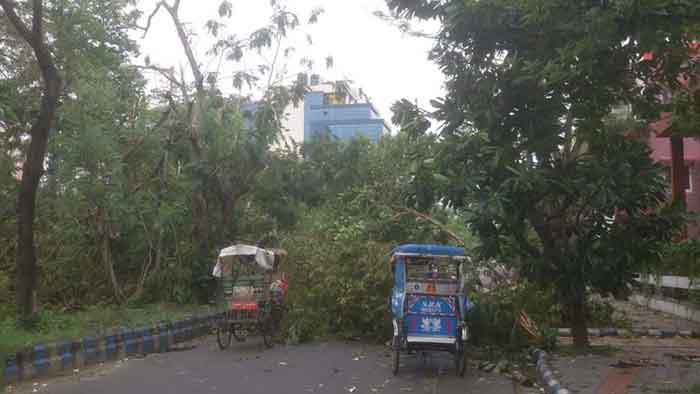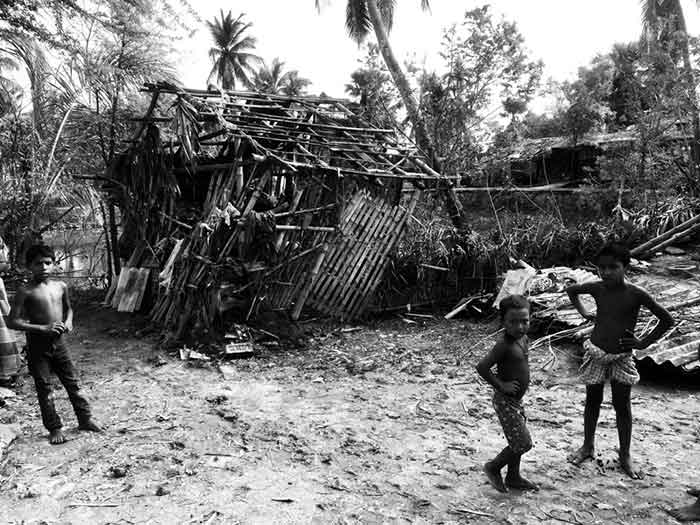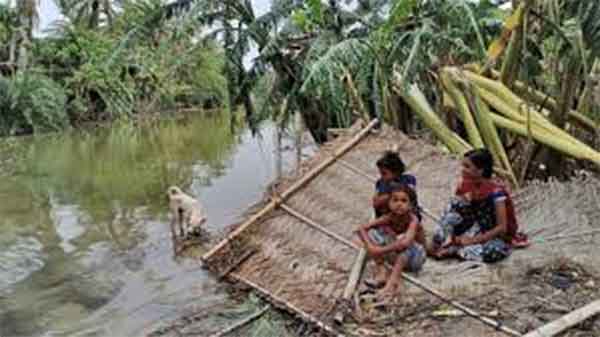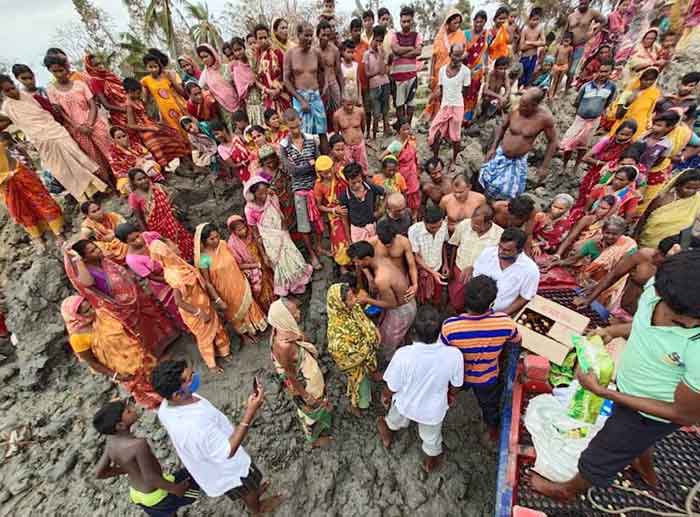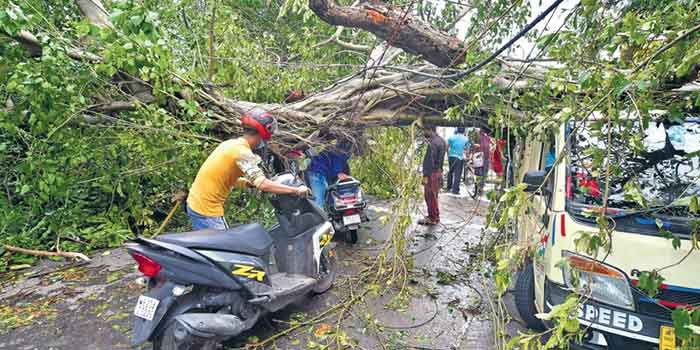
I live in North Kolkata, West Bengal. I stand witness to the damaging consequences of Amphan, the strongest storm ever recorded in the Bay of Bengal. Till the afternoon of May 20th, there were heavy showers and sporadic gusts of wind in the northern part of Kolkata. The intensity of the wind increased steadily and so did the rain. By evening, all hell broke loose. All I could hear were window-glasses of neighbourhood houses breaking down, trees falling on tin roofs and parked scooters, lamp posts falling over parked cars. A tin-roof from one of our neighbour’s houses landed, flying, first on our asbestos and then damaging a part of our parapet, on the verandah. Not only was I experiencing such devastation for the first time, my parent’s generation too was uninitiated to such horror. The nerve-wrecking wind speed (maximum recorded being 133 kmph in Kolkata) interfered with the cables and the wires. We were left inside our rooms, without access to either internet or real-time news. As the fury of the storm lessened at around 11pm, I looked through the window to see the ground floor of my house drowned in sewage water. I quickly got down to see all our ground floor rooms flooded. My worst nightmare came true. Water had seeped in through the almirahs and the documents which occupied the lowest shelves were all soggy. We had never felt as helpless in the face of any disaster.
Gradually, by the night, connections were restored. Regional news channels were all focusing exclusively on the ravaging effects of Amphan. National news channels, except for a handful, were suspiciously ignorant about the fright and plight of Bengal and its affected residents. The disappointment on the face of Mamata Banerjee, the Chief Minister (CM) of Bengal, while addressing the press conference, was palpably real. Two districts of Bengal, North and South 24 Parganas, have literally been reduced to mere dots on the map. The impact of the cyclone, as pointed out by the CM, has surpassed the ongoing pandemic. The double whammy of super-cyclone and Coronavirus has, it seems, wasted West Bengal, brutally.
Although the official twitter handles of the Prime Minister (PM) and the Home Minister of India carried no tweets on Amphan, when it was raging across the length and breadth of Bengal, it is only on the day after, i.e. on May 21st, that the PM assured that, ‘no stone will be left unturned in helping the affected.‘ Although the Home Minister has urged people to ‘stay indoor‘, ground reality has compelled people to venture outdoors. Not only have people spent their nights on cramped staircases to avoid rooms filled with sewage water, there are people whose houses have succumbed to the ravaging wind. It is human to try and rescue whatever little they can from inside those dilapidated structures. Although the regional government has made arrangements for shelter homes for most of these people, they cannot be used to their fullest capacity because of the norm of social distancing that has to be maintained in view of the ongoing pandemic. With Lockdown 4.0 operational across Bengal, with cases of COVID-19 surging in the state, with water, electric and network connections snapped in large parts, it is crucial for the two sets of government, otherwise sharing a politically acrimonious relationship, to enliven the spirit of cooperative federalism to combat the damages unleashed by Amphan.
The death toll in Bengal presently stands at 72. The administration has not been able to access parts of North and South 24 Parganas. The death toll is therefore anticipated to rise. More than 5000 houses have been razed to the ground in North 24 Parganas alone. The Bengal CM in her press address on May 21st, has urged the PM to visit the state to inspect the damage which, according to her estimate, stands at around 1 lakh crore. It has been notified that the PM will conduct aerial surveys in the states of Odisha and West Bengal on Friday and ‘take part in review meetings’ to deliberate on rehabilitation packages. In this context, a crucial aspect of CM Banerjee’s appeal to the PM should be granted further attention.
Mamata Banerjee has insisted the PM to provide Bengal with financial relief from the National Disaster Relief Fund (NDRF) indirectly urging the Centre to declare Amphan as a ‘National Disaster’. The left intelligentsia and a major part of the Bengal civil society is brazenly urging the Centre to do the same. While there are no fixed criterions for defining any calamity as National Disaster, the Centre has the option to declare Amphan as a calamity of ‘rare severity’. Such a declaration will enable the state government of West Bengal to seek support ‘at the national level’. However, lack of a proper definition regarding what constitutes a ‘calamity of rare severity’ gives the Central government an opportunity to cherry-pick. When it comes to matters of finances, ignorance is bliss for most governments. But predates strengthen claims of the postdates.
Cyclone Fani which ravaged Odisha in 2019 was declared by the incumbent government as a cyclone of ‘extreme severity’. It enabled the Orissa government to seek Rs 17,000 crore as assistance from the Centre. Fani killed at least 77 people. Killings by Amphan are fast closing in. Comparisons have been drawn between the two, both being ‘extremely severe cyclonic storms’. Legally and ethically, like cases are to be treated alike.
When politicians fight the politicians, it is the people who die. Political mudslinging will continue. But, keeping in view the ferocity of the cyclone and the inhuman human suffering that it has entailed, it is time the Central government responds to the calls of the state government. In addition to closely ‘monitoring the situation’, the Centre should promptly allocate funds under the NDRF. Conversely, the state administration should assist the central administration logistically and with data, thereby helping in crisis assessment. Politics indeed makes strange bedfellows. Crisis too: but for humanity’s sake.
Shamayita Sen is pursuing her MPhil. in Social Sciences at the Centre For Studies in Social Sciences Calcutta after having completed Masters in International Relations with specialization in Political Science from Jadavpur University. Her area of interest includes subaltern studies, social movements and collective memory. The author can be contacted at [email protected].
SIGN UP FOR COUNTERCURRENTS DAILY NEWS LETTER

